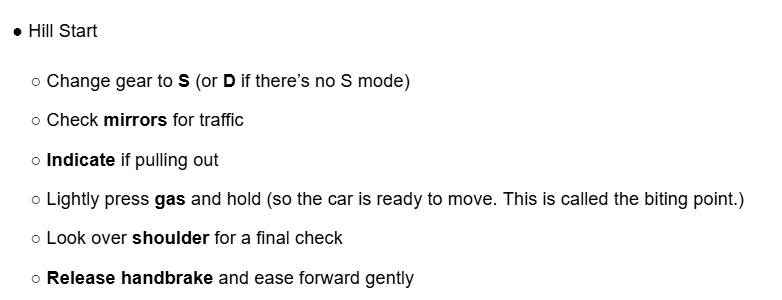This post may contain affiliate links, which means we’ll receive a commission if you purchase through our link, at no extra cost to you. Please read full disclosure here.
This post is all about how to make good driving notes.

Almost every skill worth bragging about comes with a rulebook.
- Cooking a killer curry? Follow the recipe.
- Making a dress? Stick to the sewing pattern.
- Learning French? Bonjour, grammar rules.
Skip the guidelines and you’ll wind up with a wonky lunch, a potato-sack “dress,” and anchovies on your pizza when you really wanted to order sausage.
You get the drift.
Driving is no different.
If you want to learn how to drive, you have to know – and actually follow – the rules of the road.
In this post, you’ll learn how to lock those rules into your brain by taking smart driving notes — not just for the written theory (like most people do), but for every sweaty-palmed, real-world manoeuvre.
I swear this was the secret weapon that led to me passing my driving test on the first try — even after dealing with anxiety about starting driving lessons.
Related:
7 Tips For Getting Over The Fear of Learning How To Drive
I Passed My Driving Test The First Time — Here’s How
What Are Driving Notes?
Driving notes are exactly what they sound like.
They are notes you take throughout your journey of learning to drive that you can reference any time you need to, even years after you’ve gotten your driver’s license.
Why Should You Take Driving Notes?
Learning the rules is the easy part of learning to drive.
During your driving lessons, a good driving instructor will break down everything you need to know.
Related:
Is It Time To Get A New Driving Instructor?
The 7 Qualities of A Good Driving Instructor
The hard part? Remembering those rules long enough for them to become muscle memory.
(That’s not just how to pass your test, it’s how you become a good driver.)
Now, if you’re the kind of person to walk into a room and forget what you came for, you see the issue.
You can learn a lot during your driving lesson, but if you just go home, make yourself some dinner, and then go to bed, good luck trying to remember much of what you learned during your next lesson, especially in the beginning.
That’s not you being “forgetful”; it’s basic neuroscience (hello, Ebbinghaus forgetting curve: we lose up to 70 % of new info within 24 hours if we don’t review it).
And that’s where your driving notes come in.
Driving notes make it easy to recall what you’ve learned in your driving lessons.
It removes the guesswork, along with that mid-lesson brain fog, so you can make fewer mistakes and improve faster.
The Science-Backed Payoff
I didn’t know any of this at the time, but here are some scientific reasons why driving notes work so ridiculously well:
- Active recall – Typing (or writing) forces your brain to re-create the rule/skill, cementing it far deeper than passive listening.
- Spaced repetition – Reading through notes before each lesson naturally spaces your reviews, slicing that forgetting curve in half.
- Metacognition – Noting your mistakes and weaknesses (which we’ll talk about later) builds self-awareness, the secret sauce behind faster mastery.
When Should You Take Driving Notes?
The best time to take driving notes is right after your driving lesson.
I would take it on the bus home after my lesson or once I got to my house.
As soon as you leave your instructor, do a brain dump of everything you learned during that lesson, with as much detail as you can remember.
Doing this will reduce your chances of forgetting something crucial.
If you really can’t take your notes immediately after your lessons, it’s okay to do it a little later — just try not to wait until the next day!
By then, key points have already started to fade, and your notes will be far less complete and helpful. Trust me.
Where Should You Keep Your Driving Notes?
There are two places you can keep your driving notes, and we’ll talk about the pros and cons of each.
1. On Your Phone (Notes app, Google Docs, or any cloud-synced app)
Pros
- Instant access. Grab your phone the second the lesson ends and type while everything’s still crystal clear.
- Always with you. Stuck in a queue? Scroll through your notes for a quick refresher.
- Cloud backup. Syncs with other devices so you have access to your notes on any device.
Cons
- Notifications can hijack your focus. This isn’t a big deal, you just need a little self-control. (Or turn on Do Not Disturb for five minutes.)
2. In a Notebook
Pros
- Better retention. Writing by hand boosts memory, so the rules stick faster.
- Zero digital temptations. No pings, dings, or endless scroll to pull you off task.
Cons
- Takes longer. You’ll need to sit down and copy everything while it’s still fresh.
- Risk of loss. If the notebook goes missing, so do your notes—no backup safety net.
Not sure which to choose?
Go digital if convenience and backup matter most; go for pen and paper if handwriting helps ideas sink in.
Pick the format you’ll actually use consistently—that’s what turns notes into true muscle memory.
Personally, I found using my phone the easiest since it was always with me.
How To Take Driving Notes
Now let’s get into the meat of the matter. In this section, we’ll talk about what to take notes on and how.
First, you should know that your driving notes do not need to be fancy.
What it needs to be is easy to read, detailed, and most importantly, correct.
So that’s:
- Accurate: No half-remembered guesses. If you’re unsure, ask your instructor again before you leave (or Google it).
- Detailed: Enough context that it still makes sense next week.
- Readable: Future-you should be able to skim and get it instantly, even on four hours of sleep.
What To Take Notes On
1. Your Weaknesses
Your driving weaknesses are the things you consistently struggle with during your lessons.
We all have them.
For some, it’s reversing, while others have difficulty with parallel parking. (Many of us have difficulty with parallel parking 😭)
One of my many weaknesses was forgetting to check my mirrors when indicating.
Whatever yours may be, you need to write them down.
It may seem negative to think about your weaknesses instead of your strengths, but knowing your weaknesses is the key to overcoming them.
As mentioned earlier, identifying your weaknesses builds self-awareness, and it’s only when you’re very aware of what you’re doing wrong that you will change.
But here’s the trick: record the correction, not the error.
For example, here’s a tiny snippet of what I wrote in my weaknesses section:

Now let’s compare that to what I could’ve written:
| Write this (action-oriented) | Not that (error-oriented) |
| BE SURE TO STOP AT THE STOP SIGN EVEN IF THE ROAD IS CLEAR | Forgot to stop at the stop sign. |
| Turn the steering wheel twice to straighten after reversing into a gap | Didn’t turn the steering wheel enough when reversing. |
| Don’t drive too close to the center line | Drove too close to the center line. |
The difference? When you only have a few minutes to skim your notes, you want to be absorbing the right action, not replaying what you did wrong.
So you might be wondering: why bother having a weaknesses section anyway? Can’t you just include those in the rest of the notes?
Well, no.
You need a dedicated weaknesses section to remind yourself of the things you need to pay special attention to and prioritize fixing.
It keeps your attention on what matters most—the issues that could stall your progress or cost you the test.
2. Your Mistakes
Mistakes and weaknesses aren’t twins; they’re cousins.
- Weaknesses are the repeat offenders: the maneuvers you struggle with, lesson after lesson.
- Mistakes are TODAY’S slip-ups: the late signal, the missed mirror check, the rolling stop you swear you never do.
At the end of every driving lesson, make a note of all those little mistakes.
Just like with your weaknesses, the aim isn’t self-shaming; it’s self-awareness.
It’s only when you are very aware that you can do better next time, instead of letting a momentary mistake turn into a full-blown bad habit.
3. New Things You Learned (In Detail)
Finally, write down everything you learned during your lesson in as much detail as you possibly can.
Pretend you’re explaining everything you’re learning to someone who has never even touched a steering wheel.
This is important because if you write for yourself, you’ll skip “obvious” steps and assume you’ll remember them (spoiler: you won’t).
Writing for an imaginary reader forces you to spell things out clearly and completely. Future you will be very grateful.
Here’s an example of the driving notes I took for doing hill starts.

It could definitely be more detailed! Here’s an updated version that almost anyone with basic knowledge of an automatic vehicle can follow:

How To Organize Your Driving Notes
To ensure that your driving notes are easy to read, try breaking them up into clear sections.
1. Pick a Section Style
Your sections could be whatever you want. For example, you could organize your notes by:
- Progress: Start with a ‘Weaknesses’ page, then add entries by week or lesson (e.g., Week 1, Lesson 3). (This is what I did.)
- Skill: Group similar maneuvers together — Parking, Reversing, Roundabouts, and so on.
Choose one approach and stick with it so you’re never hunting for information.
2. Format for Quick Scans
- On your phone: Use large, obvious headings (H2 or bold caps) so each section stands out as you scroll.
- In a notebook: Title the top of a fresh page and leave at least two or three blank pages after it to add new details later.
3. List Steps in Order
For every skill, write the actions in numbered or bulleted points—one step per line. That way, you can follow at a glance.
4. Core Topics to Include
Feel free to add, delete, or rename, but these are a solid starting point for what to take notes on:
- The Preliminaries (seat, mirrors, seatbelt, dashboard checks)
- Starting the Car
- Moving Off & Stopping
- Indicating & Mirror Checks
- Basic Turns
- U-Turns
- Three-Point Turns
- Roundabouts
- Reversing
- Parking (parallel, bay, hill, etc.)
- Road Signs & Markings
- Driving Etiquette
Organize your notes in whatever way feels most natural to you — as long as you can open them, find a section in seconds, and act on it, you’re good.
How To Use Your Driving Notes
Your driving notes aren’t meant to sit around and gather literal or digital dust.
For them to really help you get your license and become a better driver, you NEED to read them.
Here are some good times to read through your notes:
- Before every lesson. Spend a few minutes before your lesson going over your weaknesses, what you learned last class and the mistakes you made.
- After every update. Each time you add new material, run through the whole document so old and new tips fuse together.
- At least once a week. Set aside fifteen minutes on Sunday (or any day you prefer) to reread everything and identify next-step priorities.
But don’t just skim.
Visualize yourself performing each action correctly.
Mental rehearsal isn’t woo-woo; sports-psych studies show it activates many of the same neural pathways as physical practice, speeding up muscle memory, reducing anxiety, and boosting real-world performance.
Conclusion
Taking diving notes isn’t ‘unnecessary’ or ‘overthinking’, like some people will try to tell you.
It’s a fool-proof tool that really makes a difference, and the science is there to prove it.
Setting aside a few minutes to take and read through your driving notes will prove to be extremely useful not just for passing your road test, but during your first months of driving and for as long as you need them.
Give it a try and come back to let us know how well it works!
Please email us at [email protected] to let us know about your experience with driving notes or with any questions you may have.
